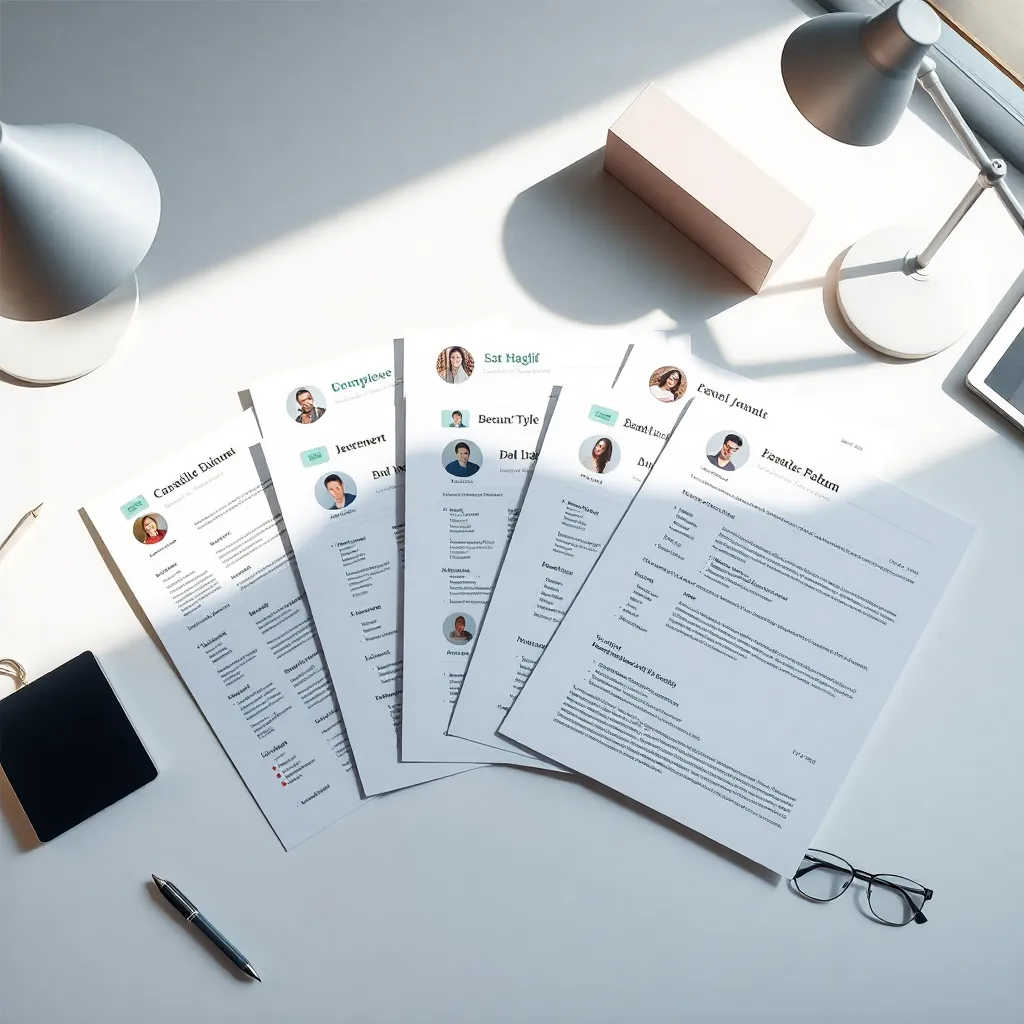In today’s competitive job market, your resume is often your first impression with potential employers. Finding the right resume maker can be the difference between landing an interview or getting lost in the application shuffle. With countless options available—from free online builders to premium services with AI capabilities—choosing the perfect platform for your needs can feel overwhelming.
This comprehensive guide examines the best resume makers of 2024, comparing features, limitations, and ideal use cases to help you create a standout resume that passes both human and automated screening systems.
How to Choose the Right Resume Maker for Your Needs
With so many resume builders available, selecting the right one depends on understanding your specific requirements, technical preferences, and career goals.
Assessing Your Resume Creation Needs
Before diving into specific platforms, consider these key factors:
-
Career Level: Entry-level candidates may need different features than executives. Junior professionals might benefit from guided templates, while senior executives might need more customization options.
-
Industry Requirements: Creative fields like graphic design often allow for more visually distinctive resumes, while corporate roles typically require more traditional, ATS-friendly formats.
-
Application Volume: If you’re applying to dozens of positions, look for tools that offer quick customization capabilities or AI-powered adaptation.
-
Technical Comfort: Consider whether you prefer drag-and-drop simplicity or code-based customization that offers more control.
-
Time Investment: Some platforms offer quick solutions in minutes, while others require more setup but deliver more personalized results.
Technical Considerations for Resume Builders
Beyond basic design capabilities, evaluate these technical aspects:
-
ATS Compatibility: According to research, 75% of resumes are rejected before a human sees them because they fail to pass through Applicant Tracking Systems. Prioritize builders like JobScan that offer ATS optimization checks to ensure your resume passes these automated filters.
-
File Formats: Ensure the platform exports to industry-standard formats (PDF, DOCX) while maintaining formatting integrity.
-
Integration Capabilities: Some resume makers connect directly with LinkedIn profiles or job boards, streamlining your application process.
-
Privacy and Data Security: Review how the platform handles your personal information, especially if you’re currently employed.
-
Cost Structure: Be wary of hidden fees or subscription traps. As TopStackResume warns, platforms like Resume.io and Zety often have auto-renewal policies that can lead to unexpected charges.
Top Free Resume Makers with Professional Results
Free resume builders can produce professional-quality documents without the price tag, though they typically come with certain limitations.
Free Resume Makers with Premium Features
These platforms offer substantial value without payment:
-
Indeed Resume Builder: This completely free tool includes specialized sections for military experience and patents, making it ideal for veterans and inventors. It seamlessly integrates with Indeed’s job board for easy applications.
-
Resume.com: Offering real-time previews and Indeed integration, this platform provides a straightforward experience with clean, professional templates.
-
Canva: While known for graphic design, Canva offers over 100 free resume templates with extensive customization options. It’s particularly valuable for creative professionals who need visually impressive documents.
-
Resume Genius: Though not entirely free, their $2.95 trial provides access to 50,000+ pre-written bullet points and cover letter tools—an exceptional value for those needing content inspiration.
Limitations and Workarounds for Free Resume Builders
Free options typically come with restrictions:
-
Download Limitations: Many free platforms restrict PDF downloads or add watermarks to exported files.
-
Template Restrictions: Free tiers often limit access to premium templates or customization options.
-
Feature Paywalls: Advanced features like ATS optimization or AI content suggestions are typically reserved for paid users.
Workarounds: To maximize free offerings, consider:
- Using free trials strategically during your job search peak
- Combining multiple free platforms (one for design, another for content suggestions)
- Seeking open-source alternatives on GitHub that offer more flexibility
Professional Resume Building Services and Premium Software
When free options don’t meet your needs, premium resume makers offer advanced features that can justify their cost.
Artificial intelligence is transforming resume creation with these standout platforms:
-
Zety: At $23.70 for a 4-week subscription, Zety provides AI content suggestions tailored to specific industries and positions. Their smart content optimizer helps identify missing skills and achievements relevant to your target role.
-
Resume.io: For $24.95 per 4 weeks, this platform offers live-editing features and LinkedIn profile synchronization, ensuring consistency across your professional presence. Their ATS friendly resume builder helps optimize content for automated screening systems.
-
Dovira AI: At $5.99 weekly, Dovira offers unlimited ATS optimization checks and job-tracking analytics to monitor application performance.
-
Teal: For $9 weekly, users receive resume scoring against job descriptions and comprehensive application tracking, helping manage complex job searches.
Premium Resume Services with Human Review
Some services combine technology with professional expertise:
-
TopResume: Offers human resume reviews from industry experts who provide personalized feedback on content, formatting, and potential red flags.
-
Monster Resume Service: Provides writer-matched services based on your industry, with direct consultation calls to understand your career goals.
-
LinkedIn Premium Career: While not strictly a resume service, it includes resume optimization suggestions from industry recruiters.
The key value proposition of these services is personalized feedback that algorithms can’t provide—particularly valuable for career changers or those with unconventional work histories.
Code-Based and Developer-Focused Resume Solutions
For technically-inclined job seekers, code-based resume solutions offer unmatched customization and version control.
GitHub Pages and Open Source Resume Templates
Developers can leverage these powerful tools:
-
GitHub Pages: Host your resume as an interactive website with complete version control. This approach demonstrates technical proficiency while providing a living document that evolves with your career.
-
JSON Resume: This open standard allows developers to store resume data in a structured format that can be styled with various themes and exported to multiple formats.
-
LaTeX Templates: Particularly popular in academic and technical fields, LaTeX produces precisely formatted documents with professional typesetting.
Advanced tools for the technically inclined:
-
VisualCV: Offers open JSON/CSS customization for developers who want precise control while maintaining user-friendly interfaces.
-
CakeResume: Their Pro tier ($9/month) supports custom domains and Google Analytics tracking, ideal for developers who want to monitor resume engagement.
-
Markdown-Based Workflows: Using tools like Pandoc, developers can maintain resumes in simple Markdown and generate PDF, DOCX, or HTML outputs as needed.
These approaches particularly benefit software developers and technical professionals who can showcase their coding skills through the very document that represents them.
Mobile Resume Apps: Creating Professional Resumes On-the-Go
Modern job searching often happens on mobile devices, making dedicated apps increasingly important.
iOS vs Android Resume Applications
Both major platforms offer specialized resume creation tools:
-
Canva Mobile: Available for both iOS and Android, Canva’s mobile app provides full design capabilities with cloud synchronization, allowing seamless transitions between devices.
-
Resume Genius App: Their mobile application offers guided AI writing assistance for quickly drafting professional content when inspiration strikes.
-
Novoresume Mobile: Specializes in optimizing one-page resumes for mobile viewing, ensuring your document looks great on smaller screens.
Mobile Resume Creation Best Practices
When building resumes on mobile devices:
-
Use Cloud Sync: Ensure your work automatically saves and transfers to desktop for final formatting.
-
Focus on Content First: Use mobile sessions for content creation rather than precise formatting, which is easier on larger screens.
-
Leverage Voice-to-Text: Many mobile apps support dictation, which can be faster than typing on mobile keyboards.
-
Review on Multiple Devices: Always check how your resume appears across different screen sizes before submitting.
Mobile resume creation is ideal for updating accomplishments immediately after they occur or making quick adjustments before interviews.
Enterprise Resume Software and Solutions for Businesses
Organizations managing multiple resumes benefit from specialized enterprise solutions.
Resume Management Systems for Recruitment
These platforms help businesses standardize resume creation and management:
-
JobScan Enterprise: Offers bulk ATS compatibility checks and team dashboards for HR departments reviewing large volumes of resumes.
-
Dovira AI Teams: At $15 per user, this platform provides centralized resume templates and analytics to maintain brand consistency across all employee documents.
-
LinkedIn Talent Hub: Integrates with corporate recruitment pipelines for seamless candidate evaluation and resume management.
Beyond external recruitment, enterprise solutions support internal advancement:
-
Skills Gap Analysis: Advanced platforms identify development opportunities by comparing employee resumes to internal job requirements.
-
Standardized Formatting: Ensures all employee and candidate documents follow corporate branding guidelines.
-
Compliance Tracking: Maintains records of certifications and credentials across the organization.
These enterprise tools particularly benefit large organizations with complex hiring processes or companies with frequent internal mobility.
Optimizing Your Resume for Applicant Tracking Systems (ATS)
With 99% of Fortune 500 companies using ATS software to screen candidates, optimization is essential for job search success.
Follow these best practices for machine readability:
-
Use Standard Section Headings: Stick with conventional labels like “Work Experience” and “Education” rather than creative alternatives.
-
Avoid Complex Formatting: Tables, columns, headers, footers, and text boxes can confuse ATS systems. JobScan’s free ATS scanner identifies formatting issues that might prevent your resume from being properly parsed.
-
Choose Simple Fonts: Stick with standard options like Arial, Calibri, or Times New Roman.
-
Include Keywords Naturally: Incorporate relevant skills and terms from the job description, but avoid “keyword stuffing” that makes your resume read unnaturally.
-
Use Standard File Formats: Submit in PDF or DOCX format unless specifically instructed otherwise.
Resume Makers with ATS Simulation and Testing
These tools help verify ATS compatibility:
-
JobScan: Compares your resume against specific job descriptions to identify missing keywords and optimization opportunities.
-
Resume.io and Zety: Both offer templates designed specifically for ATS readability while maintaining visual appeal.
-
Teal: Provides resume scoring against specific job descriptions to gauge compatibility.
Choosing a true free resume builder that understands ATS requirements is crucial for job search success. The best platforms balance design appeal with machine readability.
Future Trends in Resume Creation Technology
The resume creation landscape continues to evolve with emerging technologies shaping how candidates present themselves.
Watch for these innovations gaining traction:
-
Video Integration: Platforms like Kickresume plan to add embedded video introductions by late 2025, allowing candidates to showcase communication skills and personality.
-
Interactive Elements: Clickable portfolios and project showcases are becoming more common, particularly in creative and technical fields.
-
Blockchain Verification: Resume.io is developing blockchain technology to authenticate credentials and work history, reducing the need for traditional background checks.
-
Real-Time Collaboration: VisualCV recently added multi-user editing features, enabling job seekers to collaborate with mentors or career coaches on their documents.
Preparing for the Future of Job Applications
Stay ahead of evolving requirements by:
-
Building Modular Content: Maintain a comprehensive “master resume” with all experiences and accomplishments that can be quickly customized for specific applications.
-
Developing Digital Presence: Complement traditional resumes with robust LinkedIn profiles, personal websites, or GitHub repositories.
-
Embracing AI Customization: Tools like Dovira AI now automatically generate role-specific bullet points based on job descriptions, saving time while increasing relevance.
-
Creating Multimedia Assets: Prepare short video introductions, project demonstrations, or portfolio highlights that can supplement traditional documents.
Finding Your Perfect Resume Maker
The ideal resume builder depends on your specific situation:
-
Entry-Level Professionals: Free tools like Indeed Resume Builder or Resume.com provide excellent starting points with guided creation.
-
Mid-Career Professionals: Premium services like Zety or Resume.io offer the customization and ATS optimization needed for competitive positions.
-
Technical Roles: Consider code-based solutions like GitHub Pages or JSON Resume to demonstrate technical proficiency.
-
Creative Positions: Canva and other design-forward platforms allow for visual distinction while maintaining professionalism.
-
Executive Roles: Full-service options with professional review provide the polished presentation expected at leadership levels.
Remember that your resume is an investment in your career. The right tool should save you time while producing documents that effectively showcase your qualifications and pass both human and automated screenings.
While evaluating resume makers, it’s worth highlighting ResuFit‘s unique approach to the job search process. Unlike traditional resume builders that focus solely on document creation, ResuFit offers a comprehensive toolkit that streamlines the entire application process.
With features like one-click application customization from job URLs, AI-driven document optimization for ATS systems, and interview preparation tools, ResuFit addresses the full spectrum of job search needs. Their platform can generate tailored resumes and cover letters in minutes by analyzing job descriptions, ensuring each application is specifically optimized for the position.
For job seekers managing multiple applications, ResuFit‘s ability to quickly customize documents for different positions is particularly valuable. Their claim of “30 Perfect Job Applications in Your Lunch Break” speaks to the efficiency of their approach.
Conclusion
The best resume maker for you balances your budget, technical comfort level, design preferences, and career goals. By understanding the strengths and limitations of different platforms—from free builders to premium services—you can select a tool that produces effective, professional documents tailored to your target positions.
Remember that even the most sophisticated resume maker is only as good as the content you provide. Take time to gather your accomplishments, quantify your achievements, and identify relevant keywords before starting the creation process.
With the right platform and thoughtful content, your resume will effectively showcase your qualifications to both automated systems and hiring managers, bringing you one step closer to your next career opportunity.
Whether you choose a free builder, premium service, code-based solution, or comprehensive platform like ResuFit, the most important factor is creating a document that accurately represents your skills and experience while meeting the expectations of your target industry.




















